
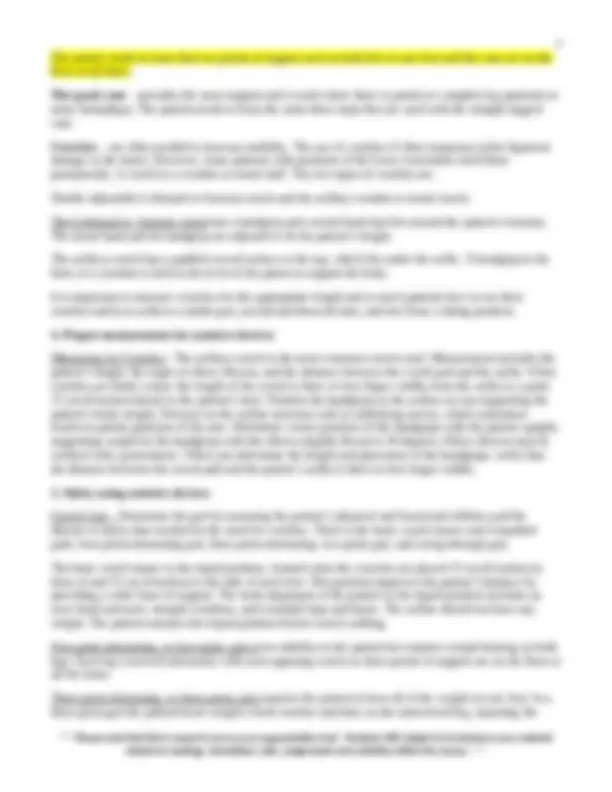
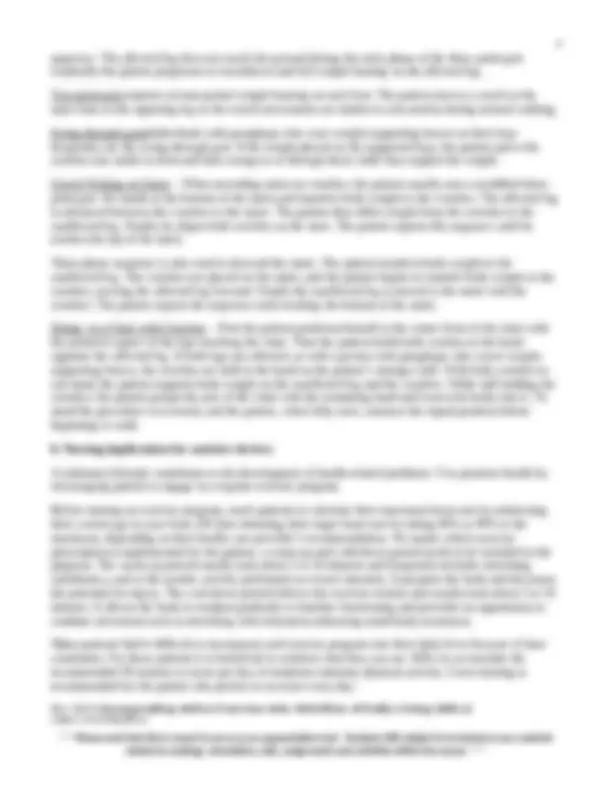
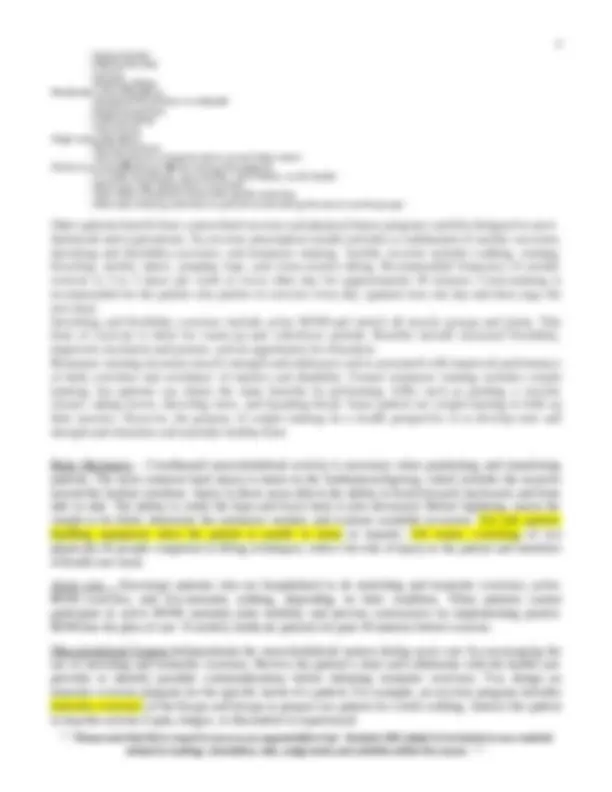

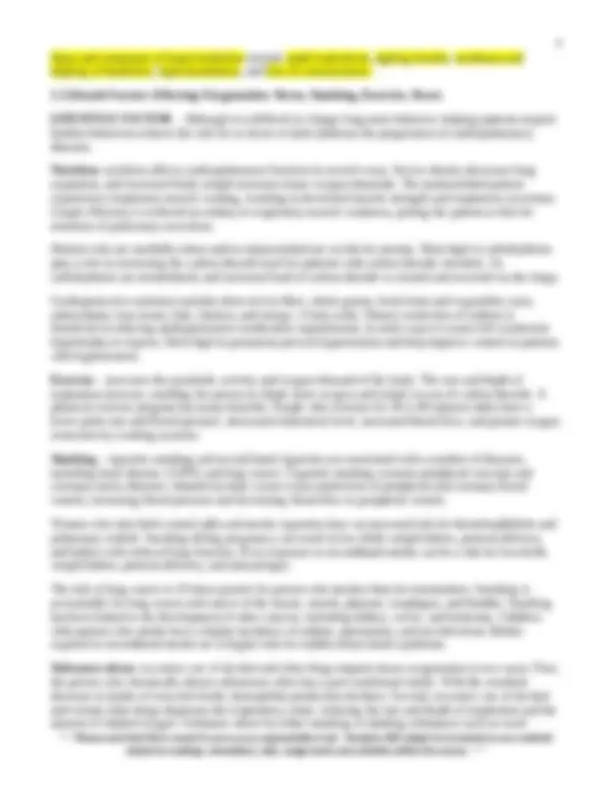
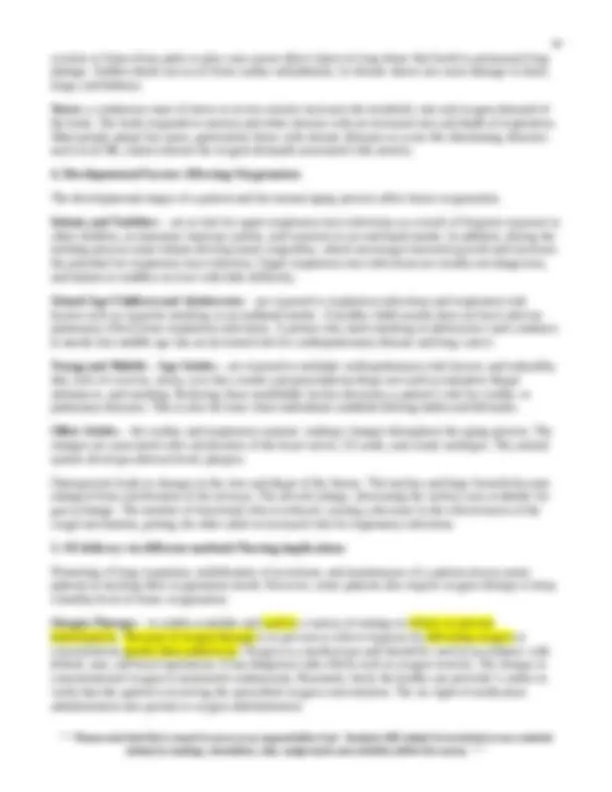
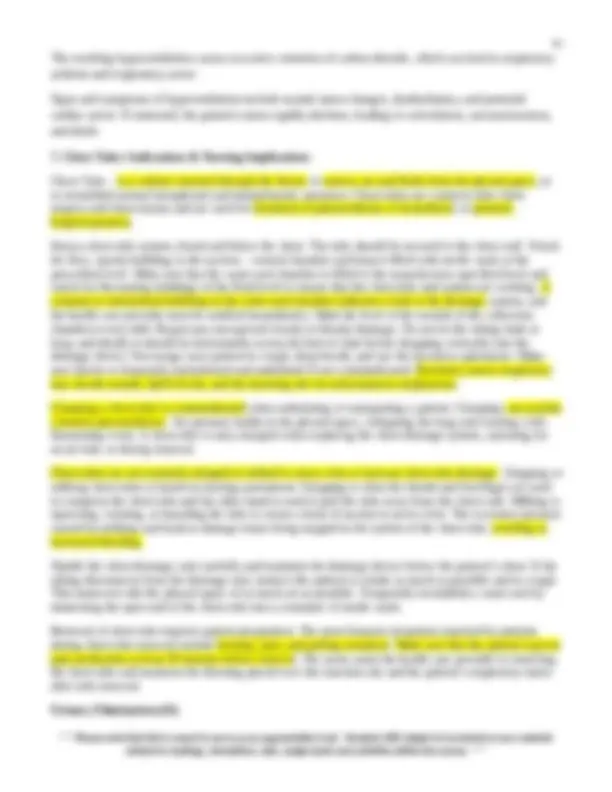
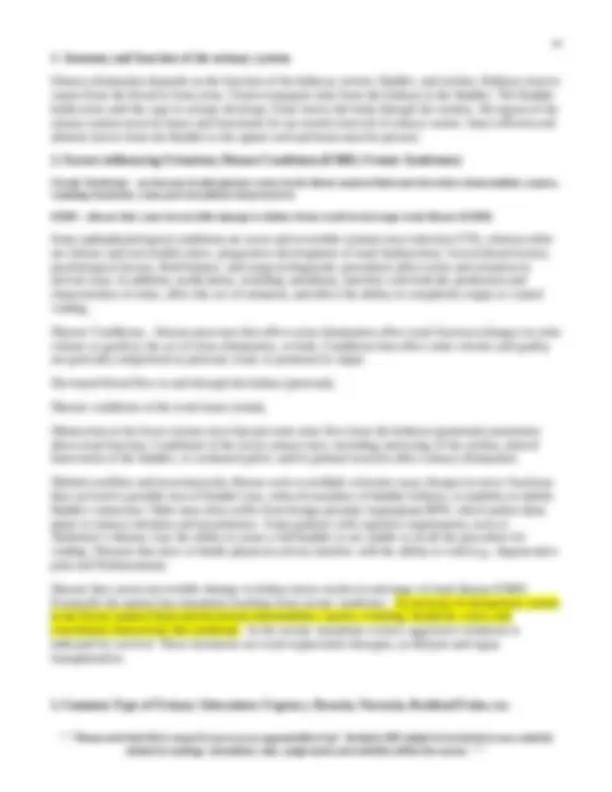
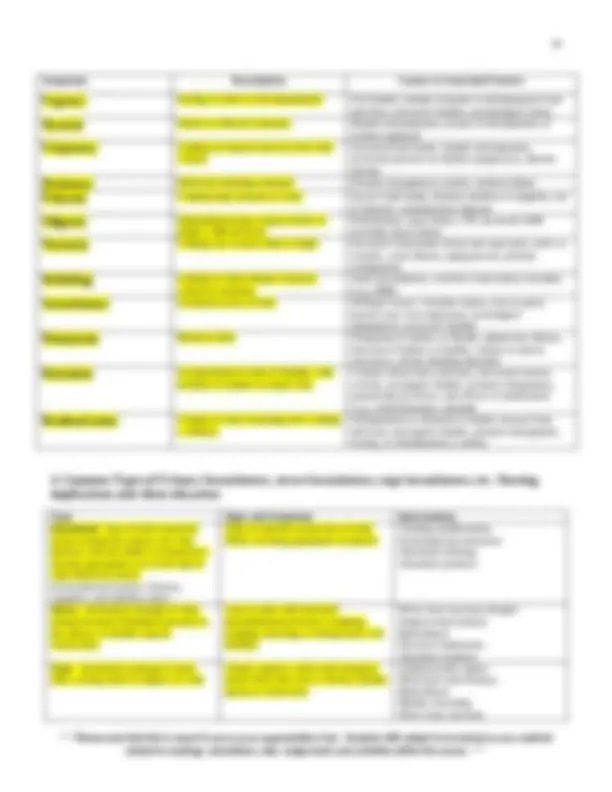
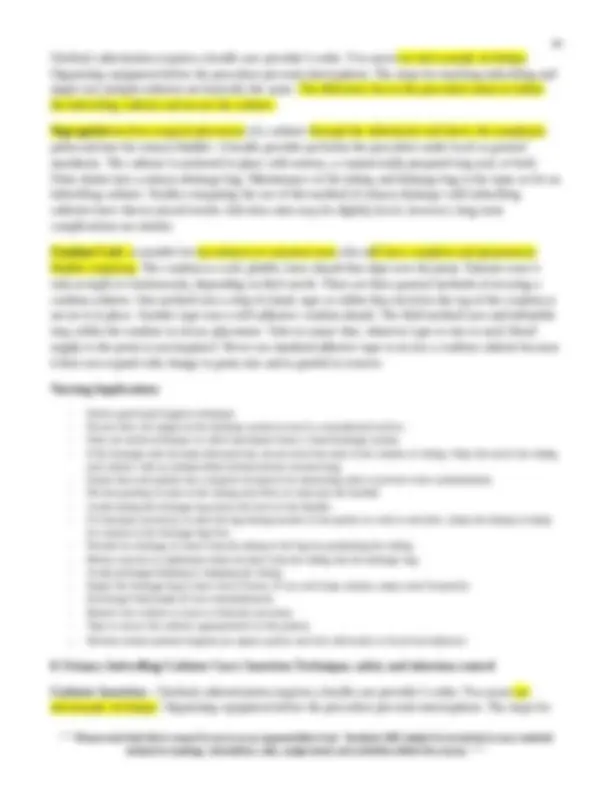
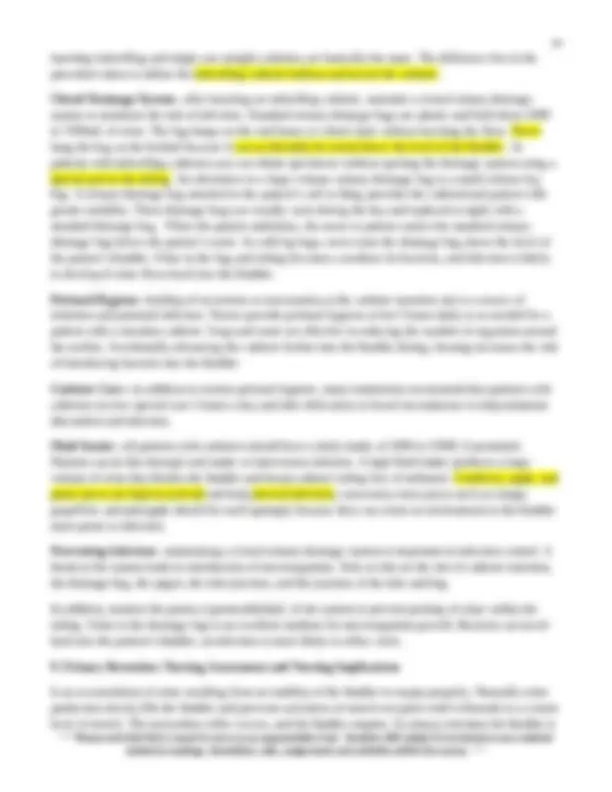
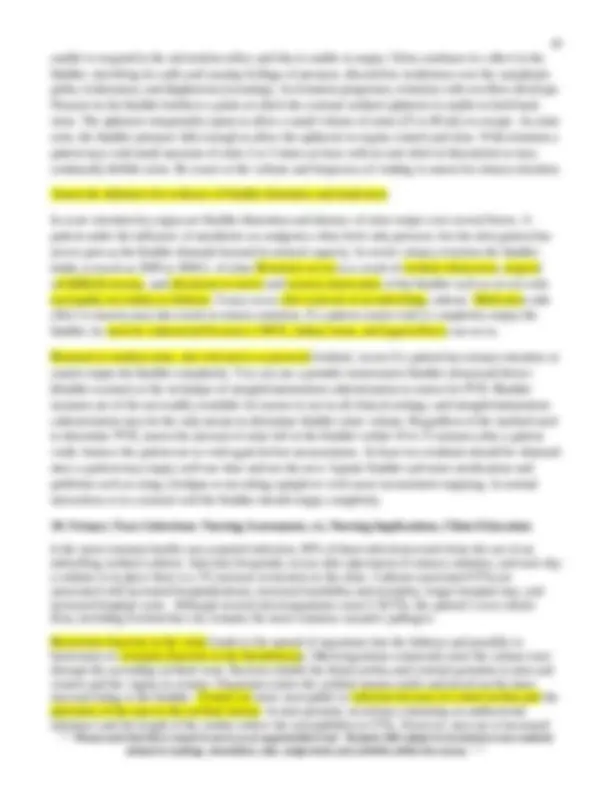
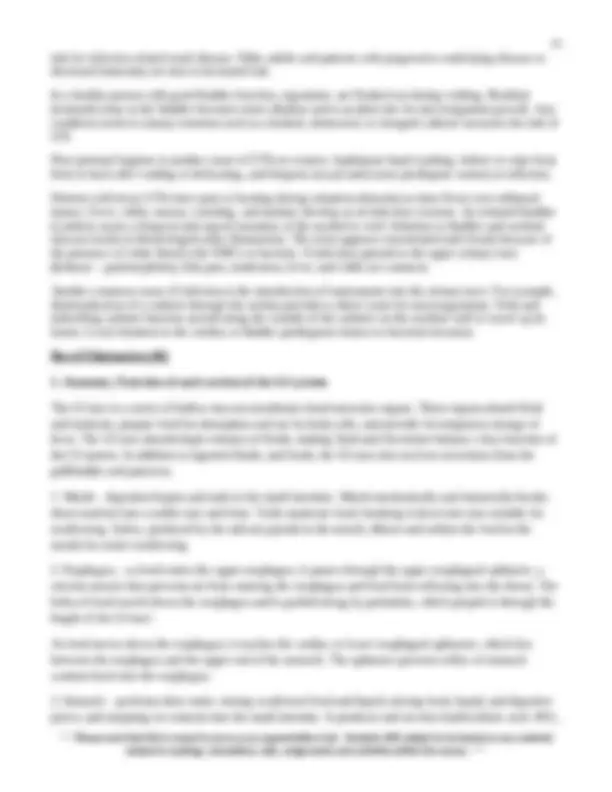
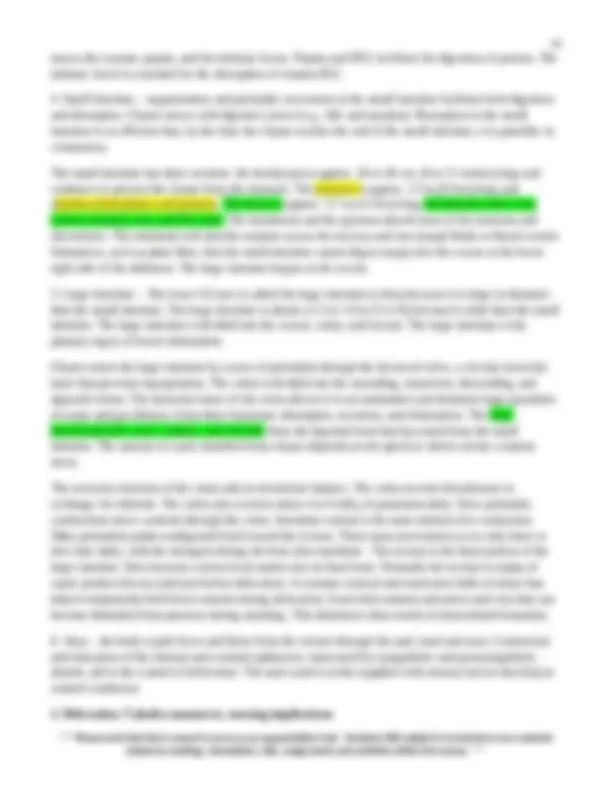
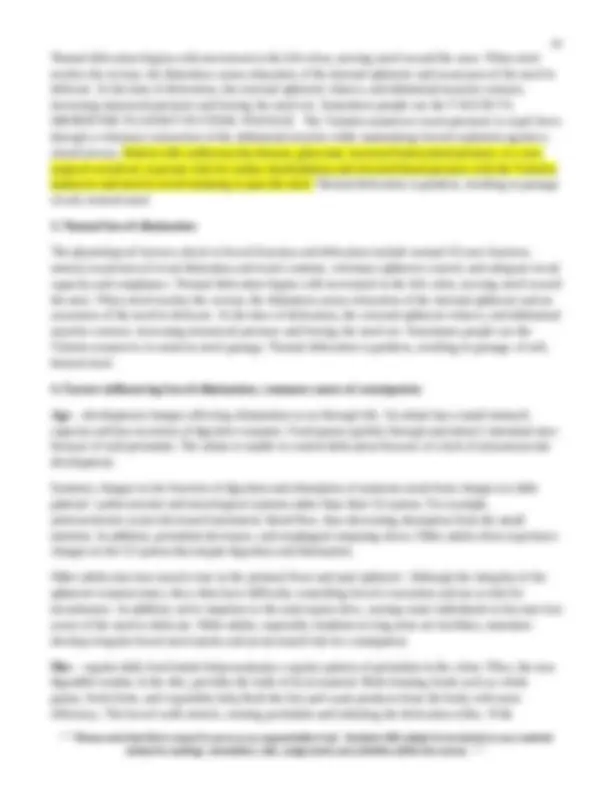
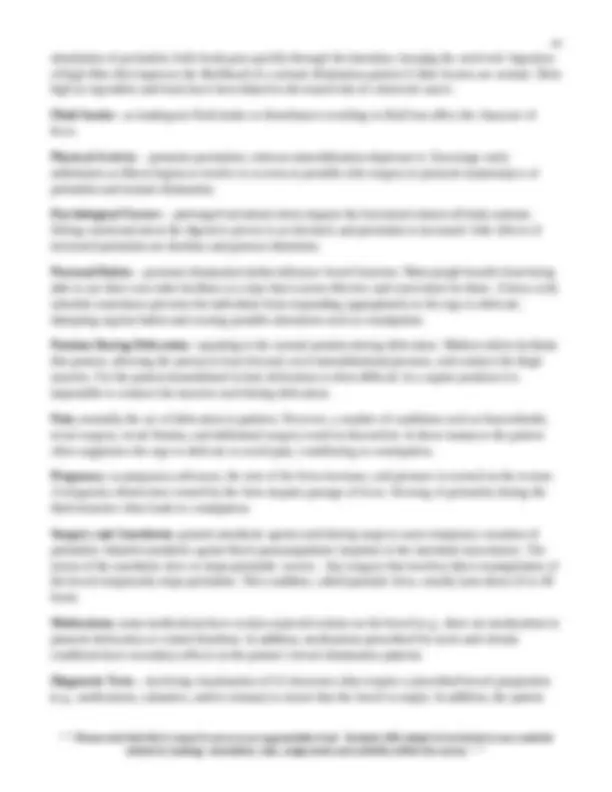
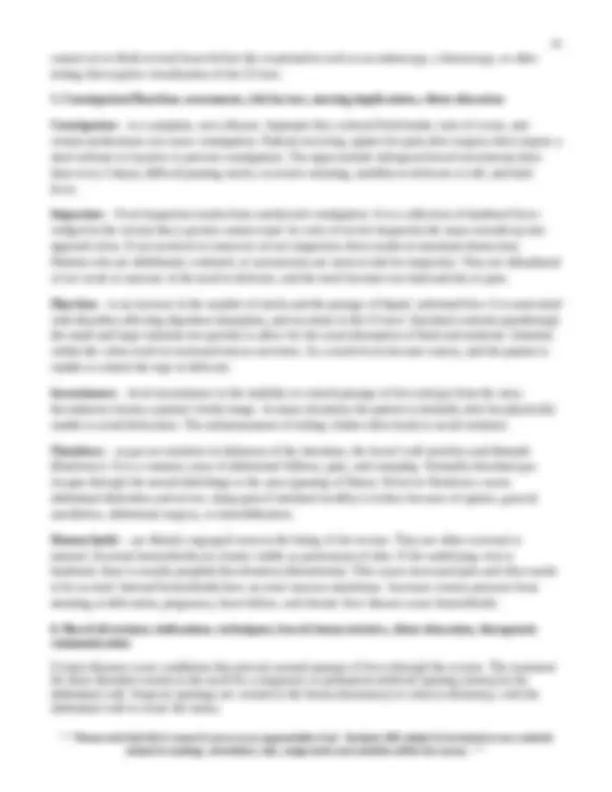
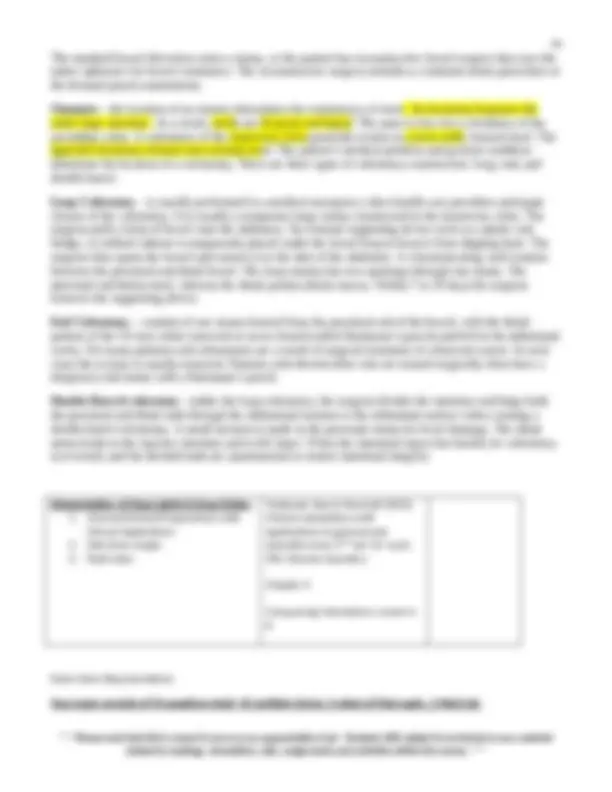



Study with the several resources on Docsity

Earn points by helping other students or get them with a premium plan


Prepare for your exams
Study with the several resources on Docsity

Earn points to download
Earn points by helping other students or get them with a premium plan
Community
Ask the community for help and clear up your study doubts
Discover the best universities in your country according to Docsity users
Free resources
Download our free guides on studying techniques, anxiety management strategies, and thesis advice from Docsity tutors
NR224 FUNDAMENTALS EXAM 3 STUDY GUIDE / NR 224 FUNDAMENTALS EXAM 3 STUDY GUIDE(New, 2024): CHAMBERLAIN COLLEGE OF NURSING(Verified,Download to score A)
Typology: Study Guides, Projects, Research
1 / 27

This page cannot be seen from the preview
Don't miss anything!




















Activity and Exercise (38)
1. Health promotion and maintenance Exercise is necessary for wellness: it conditions the body; maintains fitness; restores body to a maximum state of health; brings benefits to vital body systems (see box 38-5 below). Box 38-5 Effects of Exercise Cardiovascular System - Increased cardiac output - Improved myocardial contraction, thereby strengthening cardiac muscle - Decreased resting heart rate - Improved venous return Pulmonary System - Increased respiratory rate and depth followed by a quicker return to resting state - Improved alveolar ventilation - Decreased work of breathing - Improved diaphragmatic excursion Metabolic System - Increased basal metabolic rate - Increased use of glucose and fatty acids - Increased triglyceride breakdown - Increased gastric motility - Increased production of body heat Musculoskeletal System - Improved muscle tone - Increased joint mobility - Improved muscle tolerance to physical exercise - Possible increase in muscle mass - Reduced bone loss Activity Tolerance - Improved tolerance - Decreased fatigue Psychosocial Factors - Improved tolerance to stress - Reports of “feeling better” - Reports of decrease in illness (e.g., colds, influenza) A sedentary lifestyle contributes to the development of health-related problems o For example, Physical inactivity is a modifiable risk factor for the development of type 2 diabetes. Every person must have a plan of activities and exercise that enhances his physical fitness o The patient has to take ownership of the program of exercise First, the person needs to calculate their target heart rate: ***** Please note that this is meant to serve as an augmentation tool. Students ARE subject to be tested on any material**
o 1. Calculate the maximum heart rate: Max HR = 220 – (age of person) o 2. Calculate target heart rate Between 60% and 90% of Max HR The exercise activities require: o warm-up before the exercise: 5 to 10 min., includes stretching, or calisthenics, or the exercise itself at a lower intensity o cool-down after the exercise: 5 to 10 min., to readjust gradually to the body’s baseline functioning, includes stretching and relaxation. A well designed exercise program includes 3 types of exercises: o (1) aerobic: e.g. walking, running, bicycling, aerobic dance. Frequency 3 to 5 times per week, 30 minutes each time. o (2) resistance training: weight training to enhance muscle tone and strength, and to stimulate and maintain healthy bone. If formal weight exercise in not possible, then ADLs (Activities of Daily Living) may provide this exercise, e.g. pushing a vacuum cleaner, raking leaves. o (3) stretching and flexibility: include active ROM (Range-of-Movement) to stretch muscle groups and joints; improves flexibility, circulation, motion, and relaxation.
2. Restorative Continuing Care Involves implementing activity and exercise strategies to assist the patient with ADLs after acute care is no longer needed. Restorative and continuing care also includes activities and exercises that restore and promote optimal functioning in patients with specific chronic illnesses such as coronary heart disease CHD, hypertension, chronic obstructive pulmonary disease COPD, and diabetes mellitus. 3. Assistive devices for walking; proper technique Uses to promote activity and exercise by teaching the proper use of canes, walkers, or crutches, depending on the assistive device most appropriate for the patient’s condition. Walkers – are extremely light, movable devices that are about the waist high and made of metal tubing. The walker has four widely placed, sturdy legs. The patient holds the handgrips on the upper bars, takes a step, moves the walker forward, and takes another step. It requires a patient to lift the device up and forward. At home many patients prefer walkers with wheels or short runners on the legs that allow them to push the walker. Is important instruct patients on how to use walkers safely and avoid risk of falling. Canes – are lightweight, easily movable devices made of wood or metals. Canes provide less support than a walker and are less stable. A person’s cane length is equal to the distance between the greater trochanterand the floor. Two types of cane are the single straight-legged cane and the quad cane. The single straight-legged cane is more common and is used to support and balance a patient with decreased leg strength. Have the patient keep the cane on the stronger side of the body. For maximum support when walking, the patient places the cane forward 15 to 25 cm (6 to 10 inches), keeping body weight on both legs. The weaker leg is moved forward to the cane so body weight is dividing between the cane and the stronger leg. The stronger leg is then advanced past the cane so the weaker leg and the body weight are supported by the cane and weaker leg. ***** Please note that this is meant to serve as an augmentation tool. Students ARE subject to be tested on any material**
sequence. The affected leg does not touch the ground during the early phase of the three-point gait. Gradually the patient progresses to touchdown and full weight bearing on the affected leg. Two-point gait requires at least partial weight bearing on each foot. The patient moves a crutch at the same time as the opposing leg so the crutch movements are similar to arm motion during normal walking. Swing-through gaitsIndividuals with paraplegia who wear weight-supporting braces on their legs frequently use the swing-through gait. With weight placed on the supported legs, the patient paces the crutches one stride in front and then swings to or through them while they support his weight. Crutch Waking on Stairs – When ascending stairs on crutches, the patient usually uses a modified three- point gait. He stands at the bottom of the stairs and transfers body weight to the crutches. The affected leg is advanced between the crutches to the stairs. The patient then shifts weight from the crutches to the unaffected leg. Finally he aligns both crutches on the stars. The patient repeats this sequence until he reaches the top of the stairs. Three-phase sequence is also used to descend the stairs. The patient transfers body weight to the unaffected leg. The crutches are placed on the stairs, and the patient begins to transfer body weight to the crutches, moving the affected leg forward. Finally the unaffected leg is moved to the stairs with the crutches. The patient repeats the sequence until reaching the bottom of the stairs. Sitting in a Chair with Crutches – First the patient positions himself at the center front of the chair with the posterior aspect of the legs touching the chair. Then the patient holds both crutches in the hand opposite the affected leg. If both legs are affected, as with a person with paraplegia who wears weight- supporting braces, the crutches are held in the hand on the patient’s stronger side. With both crutches in one hand, the patient supports body weight on the unaffected leg and the crutches. While still holding the crutches, the patient grasps the arm of the chair with the remaining hand and lowers his body into it. To stand the procedure is reversed; and the patient, when fully erect, assumes the tripod position before beginning to walk.
6. Nursing implications for assistive devices A sedentary lifestyle contributes to the development of health-related problems. You promote health by encouraging patient to engage in a regular exercise program. Before starting an exercise program, teach patients to calculate their maximum heart rate by subtracting their current age in year from 220 then obtaining their target heart rate by taking 60% to 90% to the maximum, depending on their health care provider’s recommendation. No matter which exercise prescription is implemented for the patient, a warm-up and cold-down period needs to be included in the program. The warm-up period usually lasts about 5 to 10 minutes and frequently includes stretching, calisthenics, and or the aerobic activity performed at a lower intensity. It prepares the body and decreases the potential for injury. The cool-down period follows the exercise routine and usually lasts about 5 to 10 minutes. It allows the body to readjust gradually to baseline functioning and provides an opportunity to combine movement such as stretching with relaxation-enhancing mind-body awareness. Many patients find it difficult to incorporate and exercise program into their daily lives because of time constraints. For these patients it is beneficial to reinforce that they can use ADLs to accumulate the recommended 30 minutes or more per day of moderate-intensity physical activity. Cross training is recommended for the patient who prefers to exercise every day. Box 38-9 Incorporating Active Exercise Into Activities of Daily Living (ADLs) Lower-Intensity ADLs ***** Please note that this is meant to serve as an augmentation tool. Students ARE subject to be tested on any material**
Carbon monoxide CO is the most common toxic inhalant decreasing the oxygen-carrying capacity of blood. Hypovolemia – Conditions such a shock and severedehydration cause extracellular fluid low and reduced circulating blood volume, or hypovolemia. Decreased circulating blood volume results in hypoxia to body tissues. With significant fluid loss, the body tries to adapt by peripheral vasoconstriction and increasing the heart rate to increase the volume of blood returned to the heart, this increasing the cardiac output. Decreased Inspired Oxygen Concentration –with the decline of the concentration of inspired oxygen, the oxygen-carrying capacity of the blood decreases. Decreases in the fraction of inspired oxygen concentration FiO2 are caused by upper or lower airway obstruction, which limits delivery of inspired oxygen or alveoli; decreased environmental oxygen (at high altitudes); or hypoventilation (occurs in drug overdoses). Increased Metabolic Rate – Increased metabolic activity increases oxygen demand. The level of oxygenation declines when body systems are unable to meet this demand. An increased metabolic rate is normal in pregnancy, wound healing, and exercise because the body is using energy or building tissue. Most people are able to meet the increased oxygen demand and do not display signs of oxygen deprivation. Fever increases the need of tissues for oxygen; as a result carbon dioxide production increases. When fever persists, the metabolic rate remains high, and the body begins to break downprotein stress. This causes muscle wasting and decreased muscle mass, including respiratory muscles such as the diaphragm and intercostal muscles. The body attempts to adapt to the increased carbon dioxide levels by increasing the rate and depth of respiration. The patient’s SOB increases, and the patient eventually displays signs and symptoms of hypoxemia. Patient with pulmonary diseases are at greater risk for hypoxemia. CONDITIONS AFFECTING CHEST WALL MOVEMENT Any condition reducing chest wall movement results in decreased ventilation. If the diaphragm does not fully descend with breathing, the volume of inspired air decreases, delivering less oxygen to the alveoli and tissues. Pregnancy – As the fetus grows during pregnancy, the enlarging uterus pushes abdominal contents upward against the diaphragm. In the last trimester of pregnancy, the inspiratory capacity declines, resulting in dyspnea on exertion and increased fatigue. Obesity – Patients who are morbidly obese have reduced lung volumes from the heavy lower thorax and abdomen, particularly when in the recumbent and supine positions. Many morbidly obese patients suffer from obstructive sleep apnea. Musculoskeletal Abnormalities – musculoskeletal impairments in the thoracic region reduce oxygenation. Such impairments result from abnormal structural configurations, trauma, muscular diseases, and diseases of the central nervous system. Abnormal structural configuration impairing oxygenation includes those affecting the rib cage such as pectus excavatum and the vertebral column such as kyphosis, lordosis, or scoliosis. Trauma – Flail chest is a condition in which multiple rib fractures cause instability in part of the chest wall. The unstable chest wall allows the lung underlying the injured area to contract on inspiration and bulge on expiration, resulting inhypoxia. Patients with thoracic or upper abdominal surgical incisions use shallow respirations to avoid pain, which also decreases chest wall movement. Opioids used to treat pain depress the respiratory center, further decreasing respirator rate and chest wall expansion. ***** Please note that this is meant to serve as an augmentation tool. Students ARE subject to be tested on any material**
Neuromuscular Diseases – affect tissue oxygenation by decreasing the patient’s ability to expand and contract the chest wall. Ventilation is impaired, resulting in atelectasis, hypercapnia, and hypoxemia. Examples of conditions causing hypoventilation include myasthenia gravis, Guillain-Barre syndrome and poliomyelitis. Central Nervous System Alterations – diseases or trauma of the medulla oblongata and/or spinal cord result in impaired respiration. When the medulla oblongata is affected, neural regulation of respiration is impaired, and abnormal breathing patterns develop. Cervical trauma at C3 to C5 usually results in paralysis of the phrenic nerve. When the phrenic nerve is damaged, the diaphragm does not descend properly, this reducing inspiratory lung volumes and causing hypoxemia. Spinal cord trauma below the C5 vertebra usually leaves the phrenic nerve intact but damages nerves that innervate the intercostal muscles, preventing anteror-posterior chest expansion. INFLUENCES OF CHRONIC DISEASE Oxygenation decreases as a direct consequence of chronic lung disease. Changes in the antero-posterior diameter of the chest wall (barrel chest) occur because of overuse of accessory muscles and air trapping in emphysema. The diaphragm is flattened, and the lung fields are over distended, resulting in varying degrees of hypoxemia and hypercapnea.
2. Hyperventilation/Hypoventilation Hypoventilation – occurs when alveolar ventilation is inadequate to meet the oxygen demand of the body or eliminate sufficient carbon dioxide. As alveolar ventilation decreases, the body retains carbon dioxide. For example, atelectasis a collapse of the alveoli, prevents normal exchange of oxygen and carbon dioxide. As more alveoli collapse, less of the lung is ventilated, and hypoventilation occurs. In patients with COPD, the administration of excessive oxygen results in hypoventilation. These patients have adapted to a high carbon dioxide level so their carbon dioxide-sensitive chemoreceptors are essentially not functioning. Their peripheral chemoreceptors of the aortic arch and carotid bodies are primarily sensitive to lower oxygen levels, causing increased ventilation. Signs and symptoms of hypoventilation include mental status changes, dysrhythmias, and potentialcardiac arrest. If untreated, the patient’s status rapidly declines, leading to convulsions, unconsciousness, and death. Hyperventilation – is a state of ventilation in which the lungs remove carbon dioxide faster than it is produced by cellular metabolism. Severe anxiety, infection, drugs, or an acid base imbalance induce hyperventilation. Acute anxiety leads to hyperventilation and exhalation of excessive amounts of carbon dioxide. Increased body temperature (fever) increases the metabolic rate, thereby increasing carbon dioxide production. The increased carbon dioxide level stimulates an increase in the patient’s rate and depth of respiration, causing hyperventilation. Hyperventilation is sometimes chemically induced. Salicytate (aspirin) poisoning and amphetamine use result in excess carbon dioxide production, stimulating the respiratory center to compensate by increasing the rate and depth of respiration. It also occurs as the body tries to compensate for metabolic acidosis. For example, the patient with diabetes in ketoacidosis produces large amounts of metabolic acids. The respiratory system tries to correct the acid-base balance by over breathing. Ventilation increases to reduce the amount of carbon dioxide available to form carbonic acid. This can also result in the patient developing respiratory alkalosis. ***** Please note that this is meant to serve as an augmentation tool. Students ARE subject to be tested on any material**
cocaine or fumes from paint or glue cans causes direct injury to lung tissue that leads to permanent lung damage. Sudden death can occur from cardiac arrhythmias; or chronic abuse can cause damage to heart, lungs, and kidneys. Stress –a continuous state of stress or severe anxiety increases the metabolic rate and oxygen demand of the body. The body responds to anxiety and other stresses with an increased rate and depth of respiration. Most people adapt; but some, particularly those with chronic illnesses or acute life-threatening illnesses such as an MI, cannot tolerate the oxygen demands associated with anxiety.
4. Developmental Factors Affecting Oxygenation The developmental stages of a patient and the normal aging process affect tissue oxygenation. Infants and Toddlers – are at risk for upper respiratory tract infections as a result of frequent exposure to other children, an immature immune system, and exposure to second-hand smoke. In addition, during the teething process some infants develop nasal congestion, which encourages bacterial growth and increases the potential for respiratory tract infection. Upper respiratory tract infections are usually not dangerous, and infants or toddlers recover with little difficulty. School-Age Children and Adolescents – are exposed to respiratory infections and respiratory risk factors such as cigarette smoking or secondhand smoke. A healthy child usually does not have adverse pulmonary effects from respiratory infections. A person who starts smoking in adolescence and continues to smoke into middle age has an increased risk for cardiopulmonary disease and lung cancer. Young and Middle – Age Adults – are exposed to multiple cardiopulmonary risk factors: and unhealthy diet, lack of exercise, stress, over-the-counter and prescriptions drugs not used as intended, illegal substances, and smoking. Reducing these modifiable factors decreases a patient’s risk for cardiac or pulmonary diseases. This is also the time when individuals establish lifelong habits and lifestyles. Older Adults - the cardiac and respiratory systems undergo changes throughout the aging process. The changes are associated with calcification of the heart valves, SA node, and costal cartilages. The arterial system develops atherosclerotic plaques. Osteoporosis leads to changes in the size and shape of the thorax. The trachea and large bronchi become enlarged from calcification of the airways. The alveoli enlarge, decreasing the surface area available for gas exchange. The number of functional cilia is reduced, causing a decrease in the effectiveness of the cough mechanism, putting the older adult at increased risk for respiratory infections. 5. O2 delivery via different methods/Nursing implications Promoting of lung expansion, mobilization of secretions, and maintenance of a patient airway assist patients in meeting their oxygenation needs. However, some patients also require oxygen therapy to keep a healthy level of tissue oxygenation. Oxygen Therapy – is widely available and used in a variety of settings to relieve or prevent tissuehypoxia. The goal of oxygen therapy is to prevent or relieve hypoxia by delivering oxygen at concentrations greater than ambient air. Oxygen is a medical gas and should be used in accordance with federal, sate, and local regulations. It has dangerous side effects such as oxygen toxicity. The dosage or concentrationof oxygen is monitored continuously. Routinely check the health care provider’s orders to verify that the patient is receiving the prescribed oxygen concentration. The six right of medication administration also pertain to oxygen administration. ***** Please note that this is meant to serve as an augmentation tool. Students ARE subject to be tested on any material**
Safety Precaution – oxygen is highly combustible gas. Although it does not burn spontaneously or cause and explosion, it can easily cause a fire in a patient’s room if it contacts a spark from an open flame or electrical equipment. With increasing use of home oxygen therapy, patients and health care professionals need to be aware of the dangers of combustion. Supply of Oxygen – Oxygen is supplied to a patient’s bedside either by oxygen tanks or through a permanent wall-piped system. Oxygen tanks are transported on wide-based carriers that allow the amount of oxygen delivered. One common type is an upright flowmeter with a flow adjustment valve at the top. A second type is a cylinder indicator with a flow adjustment handle. In the home setting oxygen therapy is also supplied in a variety of methods, including oxygen concentrators and refillable cylinders. Methods of Oxygen Delivery Nasal Cannula – is a simple, comfortable device used for precise oxygen delivery. The two nasal prongs are slightly curved and inserted in a patient’s nostrils. To keel the nasal prongs in pace, fit the attached tubing over the patient’s ears and secure it under the chin using the sliding connector. Be alert for skin breakdown over the ears and in the nostrils from too tight an application. Attach the nasal cannula to a humidified oxygen source with a flow rate up to 6L/min (24% to 40% oxygen). Flow rates equal to or greater than 4 L/min have a drying effect on the mucosa and thus need to be humidified. Know which flow rate produces a given percentage of inspired oxygen concentration. Oxygen Masks – is a plastic device that fits snugly over the mouth and nose and is secured in place with a strap. It delivers oxygen as the patient breathes through either the mouth or nose by way of a plastic tubing at the base of the mask that is attached to an oxygen source. An adjustable elastic band is attached to either side of themask that slides over the head to above the ears to hold the mask in place. There are two primary types of oxygen masks: those delivering low concentrations of oxygen and those delivering high concentrations. The simple face mask is used for short-term oxygen therapy. It fits loosely and delivers oxygen concentrations from 35% to 50% FIO2. The mask is contraindicated for patients with carbon dioxide retention because retention can be worsened. Flow rates should be 5 L or more to avoid rebreathing exhaled carbon dioxide retained in the mask. Be alert to skin breakdown under the mask with long-term use. A plastic face mask with a reservoir bag is capable of delivering higher concentrations of oxygen. A partial rebreather mask is a simple mask with a reservoir bag that should be at least 70% FIO2 with a flow rate of 6 to 10 L/min. When used as a nonbreather mask, a similar face mask has one-way valves that present exhaled air from returning to the reservoir bag. The flow rate should be a minimum of 10 L/min and deliver FIO2 of 60% to 80%. Frequently inspect the reservoir bag to make sure that it is inflated. If it is deflated, the patient is breathing large amounts of exhaled carbon dioxide. High-flow systems should be humidified. The Venturi mask deliver higher oxygen concentrations of 24% to 60% with oxygen flow rates of 4 to 12 L/min. depending on the flow-control meter selected. Home Oxygen Therapy - Indications for home oxygen therapy include an arterial partial pressure PaO of 55 mm Hg or less or an arterial oxygen saturation SaO2 of 88% of less on room air at rest, on exertion, or with exercise. Home oxygen therapy is administered via nasal cannula or face mask. Patients with permanent tracheostomies use either a T tube or tracheostomy collar. Home oxygen therapy has beneficial effects for patients with chronic cardiopulmonary disease. This therapy improves patients exercise tolerance and fatigue levels and in some situations assist in the management of dyspnea. ***** Please note that this is meant to serve as an augmentation tool. Students ARE subject to be tested on any material**
The resulting hypoventilation causes excessive retention of carbon dioxide, which can lead to respiratory acidosis and respiratory arrest. Signs and symptoms of hypoventilation include mental status changes, dysrhythmias, and potential cardiac arrest. If untreated, the patient's status rapidly declines, leading to convulsions, unconsciousness, and death.
7. Chest Tube: Indications & Nursing Implications Chest Tube – is a catheter inserted through the thorax to remove air and fluids from the pleural space, or to reestablish normal intrapleural and intrapulmonic pressures. Chest tubes are common after chest surgery and chest trauma and are used for treatment of pneumothorax or hemothorax to promote lungreexpansion. Keep a chest tube system closed and below the chest. The tube should be secured to the chest wall. Watch for slow, steady bubbling in the suction – control chamber and keep it filled with sterile water at the prescribed level. Make sure that the water-seal chamber is filled to the manufacturer specified level and watch for fluctuating (tidaling) of the fluid level to ensure that the chest tube and system are working. A constant or intermittent bubbling in the water-seal chamber indicates a leak in the drainage system, and the health care provider must be notified immediately. Mark the level of the outside of the collection chambers every shift. Report any unexpected cloudy or bloody drainage. Do not let the tubing kink or loop, and ideally it should lie horizontally across the bed of chair before dropping vertically into the drainage device. Encourage your patient to cough, deep breath, and use the incentive spirometer. Make sure that he is frequently repositioned and ambulated if not contraindicated. Routinely assess respiratory rate, breath sounds, SpO2 levels, and the inserting site for subcutaneous emphysema. Clamping a chest tube is contraindicated when ambulating or transporting a patient. Clamping can resultin a tension pneumothorax. Air pressure builds in the pleural space, collapsing the lung and creating a life- threatening event. A chest tube is only clamped when replacing the chest drainage system, assessing for an air leak, or during removal. Chest tubes are not routinely stripped or milked to move clots or increase chest tube drainage. Stripping or milking chest tubes is based on nursing assessment. Stripping is when the thumb and forefinger are used to compress the chest tube and the other hand is used to pull the tube away from the chest wall. Milking is squeezing, twisting, or kneading the tube to create a burst of suction to move clots. The excessive pressure caused by milking and leads to damage tissue being trapped in the eyelets of the chest tube, resulting in increased bleeding. Handle the chest drainage unit carefully and maintain the drainage device below the patient’s chest. If the tubing disconnects from the drainage unit, instruct the patient to exhale as much as possible and to cough. This maneuver rids the pleural space of as much air as possible. Temporally reestablish a water seal by immersing the open end of the chest tube into a container of sterile water. Removal of chest tube requires patient preparation. The most frequent sensations reported by patients during chest tube removal include burning, pain, and pulling sensation. Make sure that the patient is given pain medication at least 30 minutes before removal. The nurse assist the health care provider in removing the chest tube and monitors the dressing placed over the insertion site and the patient’s respiratory status after tube removal. Urinary Elimination (45) ***** Please note that this is meant to serve as an augmentation tool. Students ARE subject to be tested on any material**
1. Anatomy and function of the urinary system Urinary elimination depends on the function of the kidneys, ureters, bladder, and urethra. Kidneys remove wastes from the blood to form urine. Ureters transport urine from the kidneys to the bladder. The bladder holds urine until the urge to urinate develops. Urine leaves the body through the urethra. All organs of the urinary system must be intact and functional for successful removal of urinary wastes. Intact efferent and afferent nerves from the bladder to the spinal cord and brain must be present. 2. Factors influencing Urination; Disease Conditions (ESRD, Uremic Syndrome) Uremic Syndrome – an increase in nitrogenous wastes in the blood, marked fluid and electrolyte abnormalities, nausea, vomiting, headache, coma and convulsions characterized. ESRD – disease that cause irreversible damage to kidney tissue result in end-stage renal disease (ESRD) Some pathophysiological conditions are acute and reversible (urinary tract infection UTI), whereas other are chronic and irreversible (slow, progressive development of renal dysfunction). Sociocultural factors, psychological factors, fluid balance, and surgical diagnostic procedures affect urine and urination in several ways. In addition, medications, including anesthesia, interfere with both the production and characteristics of urine, affect the act of urination, and affect the ability to completely empty or control voiding. Disease Conditions – disease processes that affect urine elimination affect renal function (changes in urine volume or quality), the act of urine elimination, or both. Conditions that affect urine volume and quality are generally categorized as prerenal, renal, or postrenal in origin. Decreased blood flow to and through the kidney (prerenal), Disease conditions of the renal tissue (renal), Obstruction in the lower urinary tract that prevents urine flow from the kidneys (postrenal) sometimes alters renal function. Conditions of the lower urinary tract, including narrowing of the urethra, altered innervation of the bladder, or weakened pelvic and/or perineal muscles affect urinary elimination. Diabetes mellitus and neuromuscular disease such as multiple sclerosis cause changes in nerve functions that can lead to possible loss of bladder tone, reduced sensation of bladder fullness, or inability to inhibit bladder contraction. Older men often suffer from benign prostatic hyperplasia BPH, which makes them prone to urinary retention and incontinence. Some patients with cognitive impairments, such as Alzheimer’s disease, lose the ability to sense a full bladder or are unable to recall the procedure for voiding. Diseases that slow or hinder physical activity interfere with the ability to void (e.g.; degenerative joint and Parkinsonism). Disease that causes irreversible damage to kidney tissue results in end-stage of renal disease ESRD. Eventually the patient has symptoms resulting from uremic syndrome. An increase of nitrogenous wastes in the blood, marked fluid and electrolyte abnormalities, nausea, vomiting, headache, coma, and convulsions characterize this syndrome. As the uremic symptoms worsen, aggressive treatment is indicated for survival. These treatments are renal replacement therapies, as dialysis and organ transplantation. 3. Common Type of Urinary Alterations: Urgency, Dysuria, Nocturia, Residual Urine, etc. ***** Please note that this is meant to serve as an augmentation tool. Students ARE subject to be tested on any material**
Lifestyle modifications (smoking cessation, weight loss and fluid modifications) Absorbent products Mixed – combination of urge and stress urinary incontinence signs and symptoms Combination or urge and stress symptoms Main treatments usually based on symptoms that are most bothersome to patient Overflow Incontinence – involuntary loss of urine at intervals without sensation of urge to void Relevant factors: Spinal cord dysfunction – loss of cerebral awareness or impairment of reflex arc Lack of urge to void, unawareness of bladder filling, reflex emptying when certain volume reached Intermittent catheterization Condon catheter (male) Crede’s method Hyperactive/Overactive Bladder – urinary urgency that is associated with urinary frequency and nocturia Sudden compelling desire to urinate that is difficult to deter Pelvic floor exercises (Kegel) Intake of 1.5 – 2 L of fluid a day Limit carbonated and decaffeinated Beverages Bladder training Biofeedback
5. Normal vs Abnormal Characteristics of urine Measurement and Normal Value Interpretation pH (4.6 – 8.0) pH of urine indicates acid-base balance. An acid pH helps protect against bacterial growth. Urine that stands for several hours becomes alkaline. Protein (non or up to 8 mg/100mL) Normally proteins not present in urine. It is common in renal disease because damage to glomeruli or tubules allows it to enter urine. Glucose (none) Patients with diabetes mellitus often have glucose in urine as a result of inability of tubules to resorb high glucose concentrations (>180 mg/100mL). Ingestion of high concentrations of glucose causes some glucose to appear in urine of healthy persons. Ketones (none) Patients whose diabetes mellitus is poorly controlled experience breakdown of fatty acids. End product of fat metabolism are ketones. Some patients with dehydration, starvation, or excessive aspirin usage also have ketonuria. Blood A positive test for occult blood occurs when intact erythrocytes, hemoglobin, or myoglobin is present. Blood in a routine urine specimen in a woman may be a result of contamination with menstrual fluid. Specific gravity (1.0053 – 1.030) Specific gravity measures concentration of particles in urine. High specific gravity reflects concentrated urine, and low specific gravity reflects diluted urine. Dehydration, reduced renal blood flow, and increased ADH secretion elevate specific gravity. Over hydration, early renal disease, and inadequate ADH secretion reduce specific gravity. Microscopic Examination RBCs (up to 2) (^) Damage to glomeruli or tubules allow RBCs to enter the urine. Trauma, disease, or surgery of the lower urinary tract also causes blood to be present. WBCs (0-4 per low-power field) Greater numbers indicate urinary tract infection. Bacteria (none) Bacteria indicate urinary tract infection. (Patients do not always have symptoms). Casts (none) Casts are cylindrical bodies the shapes of which take on likeness of objects within the renal tubule. Types include hyaline, WBCs, RBCs, granular cells, and epithelial cells. Their increased presence is always an abnormal finding and indicates renal alterations. Crystals (none) Crystals are the result of food metabolism. Excess crystals such as uric acid or calcium phosphate result in renal stone formation. ***** Please note that this is meant to serve as an augmentation tool. Students ARE subject to be tested on any material**
6. Urine Collections Methods. Nurses collect urine specimens for laboratory testing. The type of test determines the method of collection. Label all specimens with the patient’s name, date, and time of collection. Transport specimens to the laboratory in a timely fashion to ensure accuracy of test results. Agency infection control policies require the adherence to standard precautions by all personnel during specimen handling. Specimen Collection – the nurse collects random, clean-voided or midstream, sterile, and timed specimens. The method of collection varies based on a patient’s developmental level and the type of specimen orders. Urine Collection in Children – from infants and children if often difficult. Adolescents and school-age children are usually able to cooperate, although some are embarrassed. Preschool children and toddlers have difficulty voiding on request. It often helps to offer the child fluids 30 minutes before requesting specimen. A potty-chair or specimen hat placed under the toilet seat is usually effective. You will need to use special collection devices for infants or toddlers who are not toilet trained. You can also attach clear plastic, single-use bags with self-adhering material over the child’s urethral meatus. Do no obtain specimens by squeezing urine from the diaper because the results will be inaccurate. Collection Type/Use of Specimen Nursing Considerations Random (routine urinalysis) Collect during normal voiding or from an indwelling catheter or urinary diversion collection bag. Do not collect from indwellingcatheter drainage bad. Clean-voided or midstream (culture and sensitivity) Use a sterile specimen cup Sterile specimen (culture and sensitivity) If the patient has an indwelling catheter, collect a sterile specimen by using septic technique through the special sampling port found on the side of the catheter. Clamp the tubing below the port, allowing fresh, uncontaminated urine to collect in the tube. After wiping the port with and antimicrobial swab, insert a sterile syringe hub and withdraw at least 3 to 5 mL of urine (check agency policy) Using serile aseptic technique, transfer the urine to a sterile container. Timed urine specimens (for measuring levels of adrenocortical steroids or hormones, creatinine clearance, or protein quantity tests) Time required may be 2-, 12-, or 24-hour collections. The timed period begins after the patient urinates and ends with a final voiding at the end of the time period. The patient voids into a clean receptacle, and the urine is transferred to the special collection container, which often contains special preservatives. Each specimen must be free of feces and toilet tissue. Missed specimens make the whole collection inaccurate. Check with agency policy and the laboratory for specify instructions. 7. Catheters: Indwelling, Suprapubic, Condom Cath, Nursing Implications Indwelling – Intermittent and indwelling retention catherizations are the two forms of catheter insertion. With the intermittent technique you introduce a straight single-use catheter long enough to drain the bladder (5 to 10 minutes). When the bladder is empty, you immediately withdraw the catheter. You can repeat intermittent catherization as necessary, but each catheter insertion increases risk of trauma and infection. A second type of intermittent catheter has a curved tip. A Coude catheter is used on male patients who may have enlarged prostates that partly obstruct the urethra. It is less traumatic during insertion because it is stiffer and easier to control than the straight-tip catheter. ***** Please note that this is meant to serve as an augmentation tool. Students ARE subject to be tested on any material**
inserting indwelling and single-use straight catheters are basically the same. The difference lies in the procedure taken to inflate the indwelling catheter balloon and secure the catheter. Closed Drainage System – after inserting an indwelling catheter, maintain a closed urinary drainage system to minimize the risk of infection. Standard urinary drainage bags are plastic and hold about 1000 to 1500mL of urine. The bag hangs on the end frame or wheel-chair without touching the floor. Never hang the bag on the bedrail because it can accidentally be raised above the level of the bladder. In patients with indwelling catheters you can obtain specimens without opening the drainage system using a special port in the tubing. An alternative to a large-volume urinary drainage bag is a small-volume leg bag. A urinary drainage bag attached to the patient’s calf or thing provides the catheterized patient with greater mobility. These drainage bags are usually worn during the day and replaced at night with a standard drainage bag. When the patient ambulates, the nurse or patient carries the standard urinary drainage bag below the patient’s waist. As with leg bags, never raise the drainage bag above the level of the patient’s bladder. Urine in the bag and tubing becomes a medium for bacteria, and infection is likely to develop if urine flows back into the bladder. Perineal Hygiene – buildup of secretions or encrustation at the catheter insertion site is a source of irritation and potential infection. Nurses provide perineal hygiene at lest 3 times daily or as needed for a patient with a retention catheter. Soap and water are effective in reducing the number of organism around the urethra. Accidentally advancing the catheter further into the bladder during cleaning increases the risk of introducing bacteria into the bladder. Catheter Care – in addition to routine perineal hygiene, many institutions recommend that patients with catheters receive special care 3 times a day and after defecation or bowel incontinence to help minimize discomfort and infection. Fluid Intake – all patients with catheters should have a daily intake of 2000 to 2500L if permitted. Patients can do this through oral intake or intravenous infusion. A high fluid intake produces a large volume of urine that flushes the bladder and keeps catheter tubing free of sediment. Cranberry, apple, and prune juices are high in acid ash and help prevent infection; conversely citrus juices such as orange, grapefruit, and pineapple should be used sparingly because they can create an environment in the bladder more prone to infection. Preventing Infection – maintaining a closed urinary drainage system is important in infection control. A break in the system leads to introduction of microorganism. Sites at risk are the site of catheter insertion, the drainage bag, the spigot, the tube junction, and the junction of the tube and bag. In addition, monitor the patency (permeabilidad) of the system to prevent pooling of urine within the tubing. Urine in the drainage bag is an excellent medium for microorganism growth. Bacteria can travel back into the patient’s bladder, an infection is more likely to reflux valve.
9. Urinary Retention: Nursing Assessment and Nursing Implications Is an accumulation of urine resulting from an inability of the bladder to empty properly. Normally urine production slowly fills the bladder and prevents activation of stretch receptors until it distends to a certain level of stretch. The micturition reflex occurs, and the bladder empties. In urinary retention the bladder is ***** Please note that this is meant to serve as an augmentation tool. Students ARE subject to be tested on any material**
unable to respond to the micturition reflex and this is unable to empty. Urine continues to collect in the bladder, stretching its walls and causing feelings of pressure, discomfort, tenderness over the symphysis pubis, restlessness, and diaphoresis (sweating). As retention progresses, retention with overflow develops. Pressure in the bladder builds to a point at which the external urethral sphincter is unable to hold back urine. The sphincter temporarily opens to allow a small volume of urine (25 to 60 mL) to escape. As urine exits, the bladder pressure falls enough to allow the sphincter to regain control and close. With retention a patient may void small amounts of urine 2 or 3 times an hour with no real relief of discomfort or may continually dribble urine. Be aware or the volume and frequency of voiding to assess for urinary retention. Assess the abdomen for evidence of bladder distention and tenderness. In acute retention key signs are bladder distention and absence of urine output over several hours. A patient under the influence of anesthetics or analgesics often feels only pressure, but the alert patient has severe pain as the bladder distends beyond its normal capacity. In severe urinary retention the bladder holds, as much as 2000 to 3000 L of urine.Retention occurs as a result of urethral obstruction, surgical orchildbirth trauma, and alterations in motor and sensory innervation of the bladder such as occurs with neuropathy secondary to diabetes. It may occur after removal of an indwelling catheter. Medication side effect or anxiety may also result in urinary retention. If a patient cannot void or completely empty the bladder, he must be catheterized because a URTL, kidney stone, and hyperreflexia can occur. Retained or residual urine, also referred to as postvoid residual, occurs if a patient has urinary retention or cannot empty the bladder completely. You can use a portable noninvasive bladder ultrasound device (bladder scanner) or the technique of straight/intermittent catheterization to assess for PVR. Bladder scanners are of the not readily available for nurses to use in all clinical settings, and straight/intermittent catheterization may be the only means to determine bladder urine volume. Regardless of the method used to determine PVR, assess the amount of urine left in the bladder within 10 to 15 minutes after a patient voids. Instruct the patient not to void again before measurement. At least two residuals should be obtained since a patient may empty well one time and not the next. Spastic bladder and some medications and problems such as using a bedpan or not sitting upright to void cause inconsistent emptying. In normal micturition or in a normal void the bladder should empty completely.
10. Urinary Tract Infections: Nursing Assessment, s/s, Nursing Implications, Client Education Is the most common health care-acquired infection; 80% of these infections result from the use of an indwelling urethral catheter. Infection frequently occurs after placement of urinary catheters, and each day a catheter is in place there is a 5% increase in bacteria in the urine. Catheter-associated UTIs are associated with increased hospitalizations, increased morbidity and mortality, longer hospital stay, and increased hospital costs. Although several microorganisms cause CAUTIs, the patient’s own colonic flora, including Escherichia coli, remains the most common causative pathogen. Bacteriuria (bacteria in the urine) leads to the spread of organisms into the kidneys and possibly to bacteremia or urosepsis (bacteria in the bloodstream). Microorganisms commonly enter the urinary tract through the ascending urethral route. Bacteria inhabit the distal urethra and external genitalia in men and women and the vagina in women. Organisms enters the urethral meatus easily and travel up the inner mucosal lining to the bladder. Women are more susceptible to infection because of a short urethra and the proximity of the anus to the urethral meatus. In men prostatic secretions containing an antibacterial substance and the length of the urethra reduce the susceptibility to UTIs. However, men are at increased ***** Please note that this is meant to serve as an augmentation tool. Students ARE subject to be tested on any material**